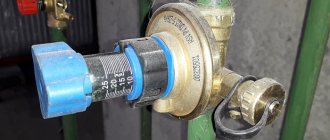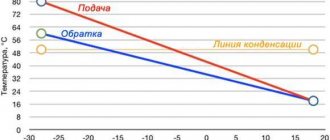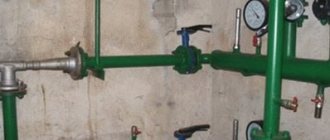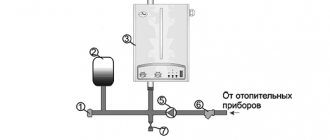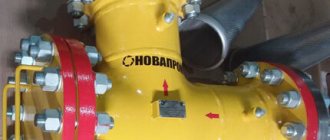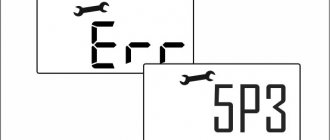Work to ensure the proper functioning of heating equipment does not end with its installation. Maintenance requires the owner to have a certain level of knowledge and constant monitoring of the condition of the system. It is important to understand why the pressure in a gas boiler drops or rises, which is why the equipment operates with fluctuations.
The article we presented describes in detail all the reasons for pressure instability in the coolant and hot water preparation system. We'll show you how to troubleshoot and keep your readings within normal range. Our recommendations will help you cope with emerging breakdowns and prevent operational failures.
Boiler gas valve operating principle and settings
The gas valve is necessary to supply gas to the burner device of the unit. By adjusting the gas valve, you can regulate the amount of fuel supplied. This makes it possible to make the unit more economical or increase the power of the device. Thus, the user, depending on the situation, has the opportunity to adjust the performance of his unit.
How does a gas valve work?
Most gas units have a SIT valve. It includes the following elements:
- gas pressure measuring port at the valve outlet;
- adjusting screw for minimum and adjusting nut for maximum fuel consumption;
- lid;
- inlet pressure measuring port.
The gas boiler valve consists of a shut-off and modulation coil. When a voltage of 220 V is applied to the shut-off valve, a minimum volume of gas is supplied to the burner in accordance with the factory settings. The voltage is then transferred to the modulation coil. The processor, depending on the operating mode (power), supplies voltage with different modulation frequencies, regulating the amount of gas passing per unit time.
To set the boiler gas valve to minimum power, you will need a differential pressure gauge, a wrench and a screwdriver. The setup process includes the following steps:
- Remove the protective cap covering the differential valve screws.
- Open the fitting to measure the gas pressure supplied to the burner - turn the locking screw 1.5-2 turns counterclockwise.
- Connect the pressure gauge hose to the inlet fitting.
- Turn on the heating mode and disconnect one wire of the modulation coil - this is necessary so that the valve supplies gas to the burner to a minimum, which will correspond to the minimum power of the unit.
- According to the pressure gauge readings, set the minimum gas pressure on the burner. To do this, rotate the internal screw located under the protective cap. At the same time, fix the outer nut.
The dynamic fuel pressure at the gas valve inlet ranges from 1.4 to 2.4 kPa. If measurements show that the pressure is outside the specified limits, it is necessary to call gas specialists.
In the factory power range, there is no need to manually reset the gas valve. This is required in order to transfer the unit to a power lower or higher than the values stated in the instructions. Often, valve adjustment is needed if the performance of the device does not correspond to the heated area of the house or apartment.
Setting the gas valve when the boiler is “clocked”
A problem such as “clocking” of a gas boiler can be solved by adjusting the gas valve. It usually occurs if the power of the unit significantly exceeds that required for a given area.
To prevent the device from “clocking” in heating mode, it is necessary to reduce the outlet pressure. This is done by turning the adjusting screw counterclockwise.
To stop “clocking” in DHW mode, reduce the maximum pressure. This can be solved by rotating the adjusting nut counterclockwise.
However, in more modern models, “clocking” is eliminated automatically. For example, setting the gas valve of the Buderus boiler is done by blocking the cycles:
- hold the button with the wrench for 5 seconds;
- select the duration of intervals from 0 to 15 minutes using the arrow buttons.
It is recommended that adjustments of this kind be carried out only by service center specialists, especially if the boiler is under warranty. Otherwise, if you damage the valve, the company will void the warranty and you will have to buy a new part.
The membrane tank has failed
If you find that the pressure in your heating boiler is dropping due to a membrane tank, but you are unable to pump it up, then it may be faulty.
A sure sign that the membrane tank needs to be replaced is the appearance of liquid droplets on the fitting when you try to pump up the pressure in it with a pump. Most likely, the membrane in it has ruptured. This can happen due to the fact that it has exhausted its resource or because at some point too much pressure has built up in the system.
But, whatever the reason for the failure of the membrane expansion tank, it will have to be replaced. They cannot be repaired.
To replace the tank, it is better to call a specialist. Since it is located inside the boiler and to carry out work you will have to disconnect the device from the supply of gas, water and electricity. If it is a wall-mounted boiler, it will need to be removed from the wall.
The work is serious and requires some skills and abilities. But, there are such jacks of all trades who manage to replace the membrane tank on their own. Moreover, it often happens that the original tank is expensive, or it is generally difficult to find it on sale. In this case, people go to all sorts of tricks, finding budget repair options.
Warm home Setting the gas pressure of Navien boilers
Setting the gas pressure of Navien boilers
To adjust the gas pressure of Navien boilers (Ace, Deluxe, Prime, Atmo), you will need a differential digital pressure gauge with a mm h3O scale
A table with gas pressure values for various Navien boiler models is given at the end
1.With the boiler turned off, attach a pressure gauge to the gas pressure control fitting on the burner
3. Set DIP switch 3 on the control board to the “ON” position, which will correspond to the minimum load.
4. Set the minimum gas pressure according to the table using the screw for setting the minimum pressure (Increase - counterclockwise, decrease - clockwise)
5. Set DIP switch 3 on the control board to the “OFF” position (Main state)
6.Set DIP switch 2 on the control board to the “ON” position, which corresponds to the maximum load
7. Set the maximum gas pressure in accordance with the table using the adjusting screw (Increase - counterclockwise, decrease - clockwise)
9. Disconnect the differential pressure gauge hose from the gas valve fitting
10. Set the DIP switch to the “OFF” position (Main state)
12. Check the tightness of the gas valve (Fitting). If abnormal noises appear, you need to check the boiler for gas leaks.
The material was prepared by an employee of heating-mtsensk.rf - Warm Home.
Source
Classification of pressure gauges for setting up gas boilers
The operating principle of all pressure gauges is based on the fact that the measured pressure is balanced by the force of a tubular spring or a double-plate membrane .
One end of it is soldered to the holder, and the other is connected to the arrow through a special mechanism. This mechanism converts the linear movement of the sensing element into the movement of the arrow along the dial.
Exemplary
Exemplary instruments are called measuring instruments that are used to calibrate others . This type of device is used to test equipment and accurately measure liquid and gas pressure; they have a higher accuracy class - 0.015-0.6 units. The increased measurement accuracy of these devices is due to the design features: the gear element in the transmission mechanism is made very accurately.
Electric contact
These devices monitor the pressure limit and notify the system when it is reached . Typically, this type of measuring equipment is used for gas, steam, and quiet liquids that are not prone to crystallization. The devices can control external electrical circuits when critical pressure is reached using a contact group or an optical pair.
Photo 1. Electric contact pressure gauge for a heating gas boiler. The device has a dial with divisions.
Special
Used to measure excess pressure in a gaseous medium. Each type of such device is designed for a specific gas, the name of which is indicated on the scale. And also special pressure gauges are marked with different colors and letters in the name . For example, a device designed to measure ammonia pressure has a yellow body color and the letter “A” in the name. This type is additionally protected from corrosion. Accuracy class of special instruments is 1.0—2.5 units.
How does the operation of a hydraulic accumulator affect pressure?
Problems with the expansion tank that affect the pressure in the heating circuit are very common. Incorrectly calculated volume of the expansion tank is one of the most characteristic prerequisites.
Malfunctions can result from improper installation, low or high pressure in the air chamber of the tank, a damaged membrane - each of the reasons can lead to disruption of coolant circulation in the system.
Expansion tank: device features and volume
If a small volume tank is installed in the heating system, it cannot compensate for the expansion of heating water when heated. At a temperature of 85-95 °C, water expands by approximately 4% and its excess volume exits through the safety relief valve.
In order for the expanzomat to fully perform its compensatory function, its capacity for systems with a gas boiler must be at least 10 percent of the total volume of water in the circuit.
If you install a tank with a larger volume than normal, the pressure fluctuations will be even smaller. Reducing pressure differences has a positive effect on the operation of the system and the service life of heating equipment
Damage to the tank membrane leads to water completely filling its volume and the pressure in the circuit drops. If you fill the volume of the circuit by opening the make-up valve, this will create a new problem - when the coolant heats up, there will be no room for it to expand and the pressure in the system will increase more than normal. The situation can only be corrected by replacing the rubber partition.
The tank should only be installed on the return pipe, in front of the heating boiler. This way the tank will have minimal impact on the operation of the circulation pump, which is installed after the gas boiler. In addition, here the water temperature is lower and the negative impact on the pressure in the system and on the tank membrane will be less.
Setting the pressure in the air chamber
The pressure formed in the air chamber of the expansion chamber can also lead to an increase or decrease in pressure inside the heating system. You can check and pump up the air in the tank only if there is no coolant in the tank.
To do this, you need to shut off access to the common circuit using shut-off valves and drain the water through the drain. Then the pressure in the air chamber is measured and inflated/lowered to the required values.
You can check the pressure in the expansion tank using a car pressure gauge, and pump it up using a car pump.
To set the pressure of the expansion tank in the air chamber, it must be 0.5 bar higher than the expected maximum pressure in the system. After the pressure in the equalizing part of the tank is adjusted, fill the circuit with cold water to the expected pressure value.
Then the air is released from the air chamber until the pressure in the heating circuit and the tank begins to decrease simultaneously - here it is necessary to simultaneously monitor the pressure in the system and in the expansion tank.
In this phase, changes in indicators are little noticeable, so you must be prepared to immediately stop bleeding air from the expansion tank as soon as a simultaneous decrease is detected.
How to choose a pressure gauge for adjusting a gas boiler
When choosing instruments, it is necessary to take into account: type, measurement range, accuracy class, size, functional load, operating conditions.
Types of devices
Based on their structure and principle of operation, there are 5 main types of sensors:
- liquid;
- spring;
- electrical contact;
- membrane;
- differential.
Spring and liquid devices are the most popular. They are quite accurate and reliable at their low price. These two types are well suited for private homes and small businesses. In most boiler rooms, spring pressure gauges are used.
Gas pressure measuring range
This is the most important parameter when choosing measuring equipment for a boiler room.
The main thing is that the operating pressure in the boiler pipe falls within the range of 1/3-2/3 of the instrument’s measurement scale. If the pressure is less, then the measurement error is too high, and if it is more, the device will be overloaded and fail before the warranty period.
Accuracy class
The lower this indicator, the more accurate the device. The accuracy class is the percentage of measurement error from the measurement scale.
The error is easy to calculate, for example, if the device is 10 atm. has an accuracy class of 1.5 units. , then its permissible error is 1.5% . If the device indicator is higher, then it must be replaced.
The malfunction can only be determined using a reference pressure gauge ; this is done by a special organization that verifies the equipment. A high-precision device is connected to the system, and then the readings are compared.
Size
The diameter of the device is selected depending on the purpose.
- 50, 63 mm - for installation on portable equipment or for monitoring the pressure of oxygen cylinders and welding machines.
- 100 mm is the most common size, most convenient in most cases.
- 160 mm, 250 mm - for monitoring devices that are located visually far away, for example, under the ceiling of a boiler room.
Functional load
Depending on the type of functional load, devices are:
- Indicating devices are technical devices. Pressure is measured.
- Signaling - control an external electrical circuit.
- For accurate measurements they have an accuracy class of 0.6-1.0 units.
- Reference ones are used to check the accuracy of other instruments.
- Recorders record blood pressure as a chart on paper.
Photo 2. Model pressure gauge for a gas boiler. The device is highly accurate and is used to calibrate other devices.
Operating conditions
The device is selected taking into account the environment in which it will be used. The environment can be different, including aggressive. There are devices with different housings; it is important to consider whether it will operate in conditions of humidity, dust, or vibration, in order to prevent the development of corrosion or damage to the housing.
What is nominal pressure and its parameters
The nominal pressure for a gas boiler is the highest permissible pressure in the system in question (gas, water), at which the device operates properly for a guaranteed period. For each specific boiler, the instructions provide its own indicators of this value.
Now let’s figure out what the working pressure (Pa) of water means - it indicates the value of the maximum permissible indicator at the outlet of the device, subject to normal operation. Before the system is filled with liquid, it is equal to atmospheric pressure, that is, 1 bar.
Examination
Checking the measuring equipment with a three-way valve is carried out as follows:
- In the working position, notice the readings of the device.
- The three-way valve is slowly turned to the left a quarter turn . The pressure gauge is disconnected from the boiler and connected to the atmosphere; the needle should smoothly return to zero.
- Slowly turn the tap back to the right a quarter turn , the arrow of the device should return to its previous position .
If the arrow moves jerkily, this means that the fitting and tap are clogged and need to be blown out . To do this, turn the tap so that water (gas) flows out, then return it to its operating position.
Important! The accuracy of the pressure gauge can only be verified using a reference instrument.
Preventing problems
Instead of solving a problem, it is better to prevent it in advance. And it's not that difficult to do.
You just need to follow certain rules:
- Carry out equipment maintenance once a year.
- Monitor the correct operation of the system.
- Correct faults in a timely manner.
Before each heating season, you should bleed the air from the radiators. It will only take a few minutes, but it will avoid problems in the future.
In addition, the quality of installation has a great influence . For those who are not particularly versed in heating, it is better to contact specialized organizations. Reworking and correcting mistakes later can be difficult.

